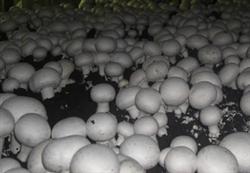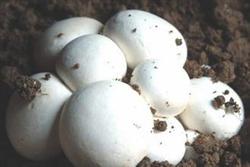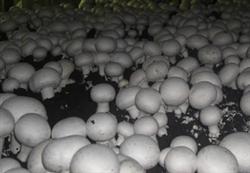Interplanting cucumber and Pleurotus ostreatus in warm winter greenhouse

In order to increase the income of the greenhouse, we made use of the warm and humid conditions and limited space in the greenhouse to carry out the three-dimensional planting experiment of vegetables and Pleurotus ostreatus. From October 1996 to May 1997, we planted 200 square meters of Pleurotus ostreatus and produced 2080 kg of Pleurotus ostreatus in a greenhouse of 420 square meters without affecting vegetable cultivation, resulting in an increase in net income of more than 6500 yuan. First, the construction of the greenhouse is the same as the general winter warm shed, which is about 60 meters long and 7 meters wide. It should be built in a place with fertile soil, convenient irrigation and drainage, and no pollution to the water quality. After the shed is built, it is re-applied with organic barnyard manure and potassium and phosphate fertilizer, deeply turned and flattened, and watered again. Then spray every corner evenly with 0.5% dichlorvos and triclofenac, and then suffocate with 6 kg of sulfur for 3 days to thoroughly kill the miscellaneous bacteria and pests in the shed. Second, the cultivation and management of cucumber. Xintai is selected as the variety of cucumber. After the first true leaf of cucumber seedlings grew in the seedling bed in early October, the pumpkin seedlings with flat cotyledons were grafted and transplanted to the cucumber border which was 1.2 meters wide and watered. Each row is 2 rows, the row spacing is 40 cm, the plant spacing is 25 cm, the frame is set up after survival, and the normal management is carried out. 3. Cultivation of Pleurotus ostreatus. Production of culture material: fermentation of culture material was carried out at the beginning of October. 1500 kg of wheat straw, 2000 kg of wet cow dung, 500kg of chicken manure, 20kg of urea, 50kg of calcium superphosphate, 50kg of lime and gypsum powder were needed for preparation, and then mixed fermentation was made for 4 times, which took 25 days. The excellent fermented material is brown, fragrant, pH 7.5, and water content 65%. two。 Culture material into the shed and sowing: at the end of October, the fermentation material was put into the shed, before that, the fermented material was sprayed with appropriate amount of dicofol and dicofol and 400 times of chlorpromazine, and it was stuffy for 24 hours. When entering the shed, cover the material in each row of cucumbers on both sides of each 20 cm wavy, north and south as a culture bed. The practice shows that this method has high yield and good mushroom quality. After entering the shed, sow seeds according to 1 bottle per square meter, and gently press the material surface. 3. Soil mulching: about 20 days after sowing, the hyphae ate 2 / 3 of the food, and then covered with soil. Before covering the soil, pour the reserved watering ditch over the flood, dig 7 cm deep the next day, and cover the soil evenly on the wave opening surface, about 3.5 cm thick. 4. Mushroom emergence: the emergence of mushroom begins about 40 days after sowing (mid-December). At this time, the cucumber vine grows to more than 1 meter, which creates a good shading environment for Pleurotus ostreatus, which is conducive to mushroom production. In management, it is necessary to spray water in time and correctly control the use of not enough water. When budding, spray mushroom water for 3 days, every day in the morning and evening temperature is relatively low, each time according to 400ml / m2 water. Then stop the water for 2 days, then spray to ensure the quality, the method is the same as above. Pleurotus ostreatus and cucumber can be listed at the same time before New Year's Day, when the temperature is low, it is the off-season of vegetables, try to prolong the time of mushroom production, so that the mycelium fully rest and recuperate and increase the total yield. Fourth, integrated management 1. Strictly control the temperature in the greenhouse: when Pleurotus ostreatus produces mushrooms, the temperature in the greenhouse should be controlled at 20: 30 ℃ in the daytime and more than 10 ℃ at night. When the greenhouse temperature is low due to lack of daylighting in cloudy days, it is necessary to use electric lights to increase the temperature appropriately at night, with a 100-watt bulb for every 6 meters. As the cultivation of Pleurotus ostreatus is underground, affected by the ground temperature, as long as the temperature in the greenhouse is not too high or too low, it has little effect on the yield of Pleurotus ostreatus. two。 Correctly grasp humidity and moisture: the temperature in the shed should generally be kept between 60% and 80%. After watering or spraying, if the outside temperature is higher, it can be properly ventilated. When intercropping, the hyphae of Pleurotus ostreatus can absorb underground water, and the water spraying should be 1 / 3 less than that of the ordinary mushroom room. 3. Rational fertilization: cucumbers should apply micro-fertilizer regularly during watering. After three batches of mushrooms, 0.2% potassium dihydrogen phosphate and 0.5% urea can be used to apply cucumber leaf surface and double spore mushroom bed surface. 4. Prevention of diseases and insect pests: during the period of stopping mushroom production, remove the mushroom root and dead mushroom in time, flatten the material surface, and then seriously spray insecticide and fungicide. Try not to use drugs, especially fungicides, during mushroom emergence to prevent damage to the mushroom body. In a word, the intercropping of vegetables and Pleurotus ostreatus solves the problem that it is difficult for Pleurotus ostreatus to produce mushrooms in winter, reduces the investment, promotes the growth of vegetables, improves the planting efficiency in greenhouse, and is worth popularizing in the northern rural areas.
- Prev

Management techniques of interplanting Pleurotus ostreatus with cucumber
When the temperature in the greenhouse is strictly controlled, the temperature in the greenhouse should be controlled at 20 ℃ ~ 30 ℃ in the daytime and more than 10 ℃ at night. When the daylighting is not enough in cloudy days, when the shed temperature is low, it is necessary to appropriately use electric lamps to increase the lighting and temperature at night, and install a 100-watt bulb every 6 meters. As the cultivation of Pleurotus ostreatus on the ground, mainly affected by the ground temperature, therefore, the shed.
- Next

Interplanting technique of Cucumber and Pleurotus ostreatus in greenhouse
The greenhouse standard required by this technology: the greenhouse is about 60 meters long and 7 meters wide. It should be built in a place with fertile soil, convenient irrigation and drainage and no pollution. After the shed is built, it is re-applied with organic barnyard manure and potassium and phosphate fertilizer, deeply flattened, and watered again. Then spray 0.5% dichlorvos evenly in every corner of the shed.
Related
- Fuxing push coffee new agricultural production and marketing class: lack of small-scale processing plants
- Jujube rice field leisure farm deep ploughing Yilan for five years to create a space for organic food and play
- Nongyu Farm-A trial of organic papaya for brave women with advanced technology
- Four points for attention in the prevention and control of diseases and insect pests of edible fungi
- How to add nutrient solution to Edible Fungi
- Is there any good way to control edible fungus mites?
- Open Inoculation Technology of Edible Fungi
- Is there any clever way to use fertilizer for edible fungus in winter?
- What agents are used to kill the pathogens of edible fungi in the mushroom shed?
- Rapid drying of Edible Fungi

